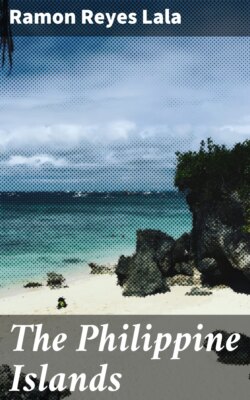Читать книгу The Philippine Islands - Ramon Reyes Lala - Страница 8
На сайте Литреса книга снята с продажи.
Discovery and Conquest.
ОглавлениеTable of Contents
When Magellan in the spring of 1521 took formal possession of Mindanao, one of the largest of the Philippine group, he was surrounded by crowds of the curious brown-skinned natives of that island; with sensations of awe, they watched their strange white visitors, believing them to be angels of light. It was Easter-week, and the Spanish discoverers, with all the ritualistic splendor of the mass, dedicated the newly-found islands to God and the Church.
The natives, too, manifested great friendliness to the tempest-tossed mariners. Indeed, one of their most prominent chieftains himself piloted the exploring party to Cebú, where thousands of natives, arrayed in all the barbarous paraphernalia of savagery, stood on the beach, and, with their spears and shields, menaced the strangers.
The Mindanao chieftain, who had acted as pilot, thereupon went on shore and volunteered an explanation: these strange voyagers were seeking rest and provisions, having been many weary months away from their own country.
A treaty of amity was then ratified according to their native custom, each party thereto simultaneously drawing and drinking blood from the breast of the other. Magellan then caused a rude chapel to be built on this new and hospitable shore, and here the natives witnessed the first rites of that Church that, within a century, extended its oppressive sway from one end of the Archipelago to the other.
The King and Queen of the natives were soon persuaded to accept the rite of baptism. This they seemed to enjoy greatly. To persuade the good-natured savages to take the oath of allegiance to the King of far-away Spain was but a step farther. One ceremony was probably as intelligible to them as the other; and thus the first two links in the fetters of the Filipinos had been forged.
The Fortifications of Old Manila.
With characteristic arrogance the Spaniards henceforth conducted themselves as the rightful masters of both the confiding natives and their opulent country.
It appears, now, that the natives of Cebú were engaged in war with another tribe on the island of Magtan. The adventurous Magellan, beholding an opportunity for conquest, and, perhaps, for profit, accompanied his allies into battle, where he was mortally wounded by an arrow.
Thus perished the brave and brilliant discoverer, in the very bloom of life, when both fame and fortune seemed to have laid their most precious offerings at his feet.
Posterity has erected a monument on the very spot where this hero was slain. Cebú also boasts an obelisk that commemorates the discovery; while on the left bank of the Pasig river, Manila, stands another testimonial to the splendid achievements of the intrepid Magellan.
Duarte de Barbosa was now chosen leader of the expedition, and he, with twenty-six companions, was invited to a banquet by Hamabar, the King of the island. In the midst of the royal festivities the Spaniards were treacherously murdered. Juan Serrano alone—so the old chronicles relate—was spared. He had, in some way, secured the favor of the natives, and now, stripped of his clothing and his armor, he was made to walk up and down the beach, in full view of his companions on board the ships.
For his person the natives shrewdly demanded a ransom of two of the Spanish cannon. A consultation was held among the Spaniards, and it was decided that it was better that one should perish than that the lives of all be jeoparded. And so Serrano was left to his fate.
